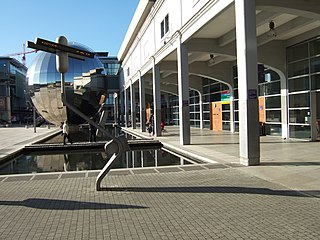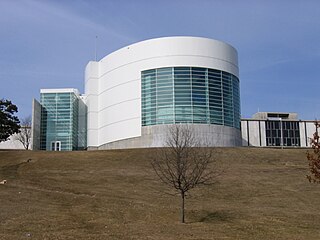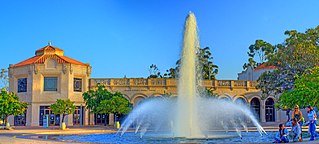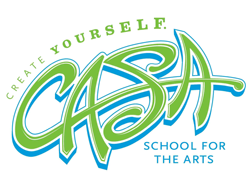
IMAX is a proprietary system of high-resolution cameras, film formats, film projectors, and theaters known for having very large screens with a tall aspect ratio and steep stadium seating, with the 1.43:1 ratio format being available only in few selected locations.

The Franklin Institute is a science museum and the center of science education and research in Philadelphia, Pennsylvania. It is named after the American scientist and statesman Benjamin Franklin. It houses the Benjamin Franklin National Memorial. Founded in 1824, the Franklin Institute is one of the oldest centers of science education and development in the United States. Its chief astronomer is Derrick Pitts.

We The Curious is a science and arts centre and educational charity in Bristol, England. It features over 250 interactive exhibits over two floors, and members of the public and school groups can also engage with the Live Science Team over programming in the kitchen, studio and on live lab. We The Curious is also home of the United Kingdom's first 3D planetarium. The centre describes its aim as being "to create a culture of curiosity".

The Science Museum of Minnesota is an American museum focused on topics in technology, natural history, physical science, and mathematics education. Founded in 1907 and located in Saint Paul, Minnesota, the 501(c)(3) nonprofit institution has 385 employees and is supported by volunteers.

The Putnam Museum and Science Center, formerly Davenport Academy of Natural Sciences, is a museum of history and natural science and a science center in Davenport, Iowa, United States. The museum was founded in 1867, and was one of the first museums west of the Mississippi River. It houses 160,000 historical artifacts and specimens and a giant screen theater. It is located at 1717 West 12th Street, at the corner of Division and West 12th Street on "museum hill," near Fejervary Park. It is an affiliate of the Smithsonian Institution.

The Fleet Science Center is a science museum and planetarium in Balboa Park, located in San Diego, California. It is at the east end of the El Prado Drive walkway, next to the Bea Evenson Fountain and plaza in central Balboa Park.

Shanghai Science and Technology Museum is a large museum in Pudong, Shanghai, close to Century Park, the largest park within the inner districts of the city. It is one of China's most-visited museums. It received 1,351,000 visitors in 2020, despite a fall of attendance of 72 percent from 2019 due to restrictions and reduced tourism imposed by the COVID-19 pandemic.

Telus World of Science Edmonton (TWOSE) is a broad-based science centre in Edmonton, Alberta, Canada, operated by the (non-profit) Edmonton Space & Science Foundation. The centre is located on the southwest corner of Coronation Park in the neighborhood of Woodcroft. The science centre houses 144,430 sq. ft. of public space and is the largest science centre in Western Canada. It is currently a member of both the Association of Science-Technology Centers (ASTC) and the Canadian Association of Science Centres (CASC).

The Denver Museum of Nature & Science is a municipal natural history and science museum in Denver, Colorado. It is a resource for informal science education in the Rocky Mountain region. A variety of exhibitions, programs, and activities help museum visitors learn about the natural history of Colorado, Earth, and the universe. The 716,000-square-foot (66,519 m2) building houses more than one million objects in its collections including natural history and anthropological materials, as well as archival and library resources.

Downtown Harrisburg is the central core neighborhood, business and government center which surrounds the focal point of Market Square, and serves as the regional center for the greater metropolitan area of Harrisburg, Pennsylvania, United States.

The Museum of Discovery and Science is a museum focused on science located in Fort Lauderdale, Florida, United States.

The Milton J. Rubenstein Museum of Science and Technology is a science and technology museum located in the Armory Square neighborhood of Downtown Syracuse, New York. The Museum includes 35,000 square feet of permanent and traveling exhibits, Science Shop, and several programs and events. The MOST is located in the former Syracuse Armory.
The Annenberg Foundation is a family foundation that provides funding and support to non-profit organizations in the United States and around the world. Some of the Foundation's core initiatives are the Annenberg/Corporation for Public Broadcasting (CPB) project, which funds many educational television shows broadcast on Public Broadcasting Service (PBS) public television in the United States as well as The Annenberg Community Beach House, The Annenberg Space for Photography, Metabolic Studio, explore.org, Wallis Annenberg PetSpace and the Wallis Annenberg Center for Performing Arts.
The Cultural District is a fourteen-square block area in Downtown Pittsburgh, USA bordered by the Allegheny River on the north, Tenth Street on the east, Stanwix Street on the west, and Liberty Avenue on the south.

Uncas Aeneas Whitaker was a prominent mechanical engineer, electrical engineer, lawyer, entrepreneur, and philanthropist. Raised in Missouri, he received a mechanical engineering degree at the Massachusetts Institute of Technology, an electrical engineering degree from Carnegie Institute of Technology and a law degree from the Cleveland Law School. At the age of 41, he founded Aircraft-Marine Products, AMP Incorporated, in Harrisburg, Pennsylvania, which would become the world's largest manufacturer of electrical devices and connectors. His company was instrumental in the development of miniature components and advanced computer technologies which have been incorporated into thousands of business operations and commercial products.
The Gulf Coast Exploreum Science Center is a non-profit science center that promotes science learning through a variety of activities, including exhibits, Digital Dome movies, demonstrations, workshops and teacher professional development. Located in downtown Mobile, Alabama, Exploreum has several permanent galleries including Hands On Hall, the Wharf of Wonder, Curiosity Factory, and My BodyWorks - a health exhibit. The Exploreum also features interactive traveling exhibits, year-round with broad science content and supplementary, themed educational programming.

The Capital Area School for the Arts (CASA) is a 9th to 12th grade, public charter school located in Harrisburg, Pennsylvania, Dauphin County, Pennsylvania, USA. The School began as an arts magnet school, which was founded in 2001 as a partnership between the Capital Area Intermediate Unit and Open Stage of Harrisburg. After first moving through several sites in downtown Harrisburg, the school now resides in its permanent location in the first and third floor of Strawberry Square. Capital Area School for the Arts Charter School utilizes a 21st-century, hybrid model of teaching and learning. The curriculum is designed to meet all of the Pennsylvania Core State Standards. In 2013, the School received charter status and converted to an intensive, all-day academic and arts high school. CASA Charter School was approved in May 2013 for five years.

The Michigan Science Center(MiSci) is a Smithsonian-affiliate science museum in Detroit, Michigan. The mission of the Michigan Science Center is to inspire curious minds of all ages to discover, explore and appreciate science, technology, engineering and math (STEM) in a creative, dynamic learning environment. As a 501(c)(3) nonprofit organization, MiSci relies on the generous support of donors, sponsors, community partners and members.

The Fort Worth Museum of Science and History is located on 1600 Gendy Street, Fort Worth, Texas 76107 in the city's Cultural District. It was opened in 1945 as the Fort Worth Children's Museum and moved to its current location in 1954. In 1968, the museum adopted its current name. Attractions at the museum include the Noble Planetarium, the Omni Theater, and the Star's Café, in addition to both traveling and permanent science and history exhibits.

The Saskatchewan Science Centre is an interactive science museum located in Regina, Saskatchewan. It is owned and operated as a not-for-profit charitable organization. Located in a former power plant in the Wascana Centre, the Saskatchewan Science Centre was officially opened in April 1989 as the Powerhouse of Discovery. In 1991 the Science Center was expanded with the addition of the Kramer IMAX Theater.




















